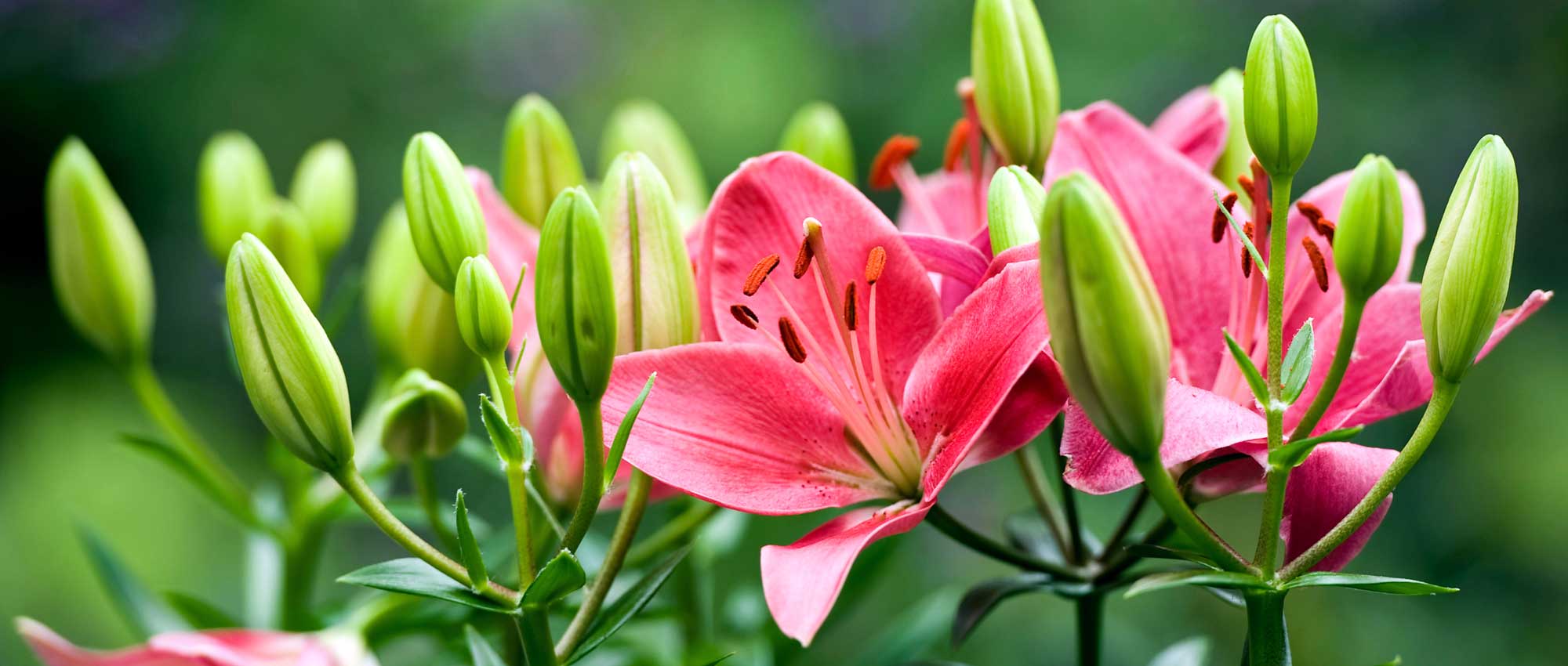
Lily: planting, cultivation and maintenance
Contents
Lily in a nutshell
- Lily offers large, majestic, and very refined flowers in summer
- There is a great diversity of flowerings and colours
- It is a hardy bulb that adapts well to pot cultivation
- Its flowering is sometimes very fragrant
- The flowers are ideal for composing bouquets
A word from our Expert
Lily is a hardy bulbous perennial that offers an impressive flowering display in summer, in a wide range of shades: white, yellow, red, pink, orange, purple… Its straight, upright stems bear large flowers, shaped like trumpets, bells, or stars. They are composed of broad petals, often punctate or spotted, surrounding decorative stamens. The lily is the very symbol of refinement and elegance.
It constitutes a well-diversified group, including Oriental Lily, Asian Lily, Martagon Lily, or Madonna Lily… Their height varies greatly: there are compact varieties suitable for pot planting, and others that can reach three metres tall! Their flowering is often pleasantly fragrant! Frequently used by florists, the lily is also one of the best cut flowers for making bouquets!
The lily prefers to be planted in full sun. It can be grown in open ground, but is also well-suited for container planting. The lily bulb should be planted quite deeply in the soil. It requires well-draining soil, rich in organic matter, and slightly acidic (with the exception of a few species like Lilium candidum). Regarding maintenance, it is important to keep the soil moist in summer and to monitor for the appearance of lily beetles, the main enemy of the lily! Overall, growing lilies is quite easy, and the bulb is hardy. It is a versatile plant that can be integrated into a flowerbed, border, cool rockery, or in pots on a terrace…
Botany
Botanical data
- Latin name Lilium sp.
- Family Liliaceae
- Common name Lily
- Flowering summer
- Height 60 cm to 2 m
- Sun exposure sun
- Soil type rich, cool, draining, rather acidic, non-calcareous
- Hardiness between -15 and -20 °C
The Lily is a perennial bulbous plant that flowers in summer. There are about 110 species, along with many horticultural varieties, sometimes with double flowers. Lilies mainly originate from Europe and southern Asia, but also from North America. They primarily grow in temperate zones of the northern hemisphere, which explains their fairly good hardiness. They can be found in undergrowth, in mountain forests, and sometimes in meadows.
The lily gave its name to the family Liliaceae, which includes monocotyledonous plants that are often bulbous and herbaceous. This family contains many ornamental plants, including fritillaries, tulips, Erythronium, and Tricyrtis.
The scientific name Lilium comes from the ancient Greek leírion. In French, several plants have taken the common name lily, by analogy with the shape of their flowers that somewhat resemble it: Inca Lily (Alstroemeria), Toad Lily (Tricyrtis hirta), Giant Himalayan Lily (Cardiocrinum), Day Lily (Hemerocallis), Malabar Lily (Gloriosa superba)…
Lilies have an upright, vertical habit. Their height is very variable: they generally measure between 60 cm and 2 m tall. Lilium pardalinum var. giganteum can reach up to 3 m. The most compact varieties are suitable for pot or container cultivation. Lilies do not spread in width. Their stems are straight and unbranched, which sometimes gives them a rather rigid appearance. Some species produce bulblets on the stems, in the axil of the leaves (Lilium bulbiferum…). This allows for easy propagation.
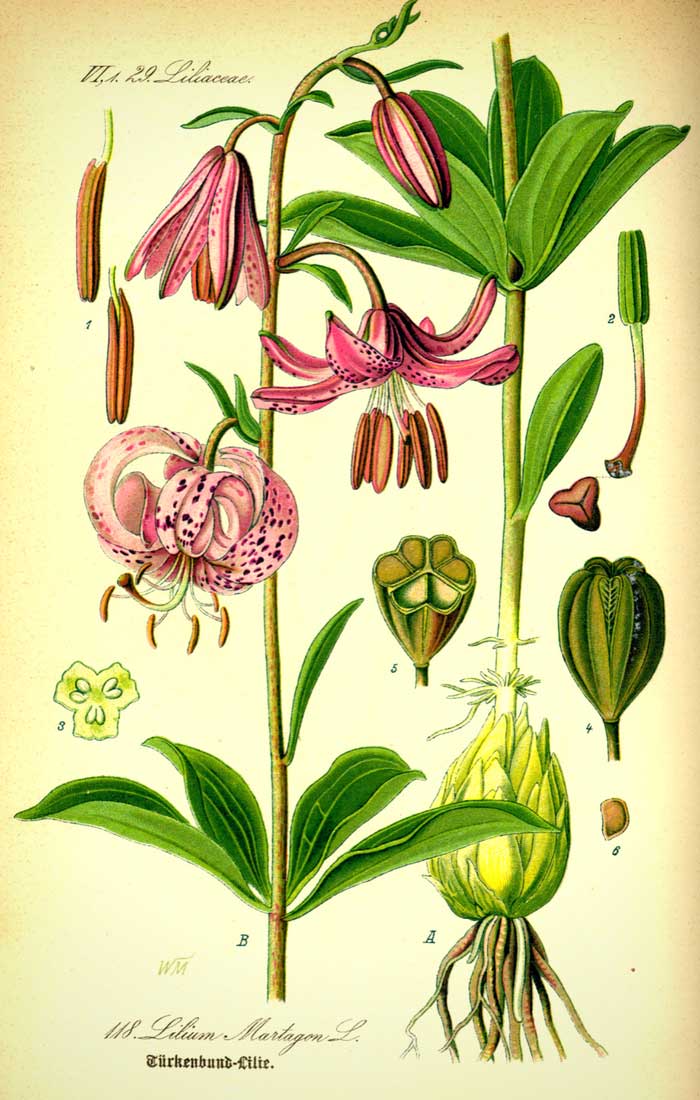
Lilium martagon: botanical illustration
Lilies begin to bloom from late spring to early summer. Depending on the varieties, flowering occurs between May-June and September.
Lilies are appreciated for their spectacular, majestic, and refined flowering. The size of the flowers is very variable, as they measure between 2 and 20 cm in diameter (sometimes even up to 30 cm!). The Martagon Lily bears small flowers (2 to 5 cm in diameter), while they are much larger in Lilium auratum.
The flowers are gathered in clusters or umbels at the top of the upright stems. They can sometimes be in large groups on the same stem: the Martagon Lily can bear up to 50 flowers! In other varieties, they can also be solitary. Lily flowers are upright, inclined, or pendulous towards the ground. They can take the shape of a cup, trumpet, star (flattened shape), or turban (reflexed petals). The petals are strongly curved backward in Lilium tigrinum.
The flowers consist of six large tepals (three petals and three sepals, which have the same appearance). They are free, not fused together. The tepals are arranged in two planes: three above, at the same level, and three inserted just below. In the centre, there are six long and often decorative stamens, which bear large anthers covered in orange pollen at their tips. The flower also has a long style, positioned in the centre. In a variety like ‘Casablanca’, the reddish-brown stamens enhance and contrast the white flowering! The pollen present on the stamens stains easily and is messy: handle the flowers with care.
Although the flowers are often simple, with six tepals, there are lilies with double flowers (horticultural hybrids), with a greater number of tepals. This is the case with Lilium orientale ‘Magic Star’. These varieties have an exuberant and sophisticated side.
The flowers generally have quite warm shades. They can be yellow, orange, red, pink, or purple. They can also be pure white, as in Lilium candidum. However, there are no lilies with blue or violet flowers. The flowers take on a very vivid and original hue in Lilium pardalinum ‘Fusion’: red on the outside and yellow in the centre, speckled with black. Sometimes, the flowers are very dark, as in the lily ‘Night Flyers’. In this case, they will add depth and contrast to the flower beds! It is quite common for the flowers to be spotted or have patterns: stripes, dots, macules… This is precisely what makes the flowering very refined. The Lilium tigrinum has the particularity of bearing tiger-like flowers, marked with black spots. Those of the lily ‘Lankon’ are very surprising, with a multitude of small purple dots, as if sprayed on the petals.

The flowering of lilies is quite varied in shapes and colours! Lilium ‘Lady Alice’, Lilium ‘White Pixels’, Lilium ‘Roselily Clara’ and Lilium lancifolium
With their very straight stems and large impressive flowers, lilies are perfect for making bouquets! The flowers can last up to two weeks in a vase. Depending on the varieties, they can be very fragrant!
The leaves of lilies are elongated, lanceolate to linear. They are dark green and glossy. They can be arranged on the stem in an alternate, whorled, or spiralled manner.
The majority of lilies are deciduous, losing their foliage in winter. The plant goes dormant to survive the harsh season. However, Lilium candidum is evergreen: its basal rosette of leaves remains in place during winter. Unlike other bulbs, it is dormant in summer.

The leaves of the lily are long and narrow, with parallel veins. Lilium japonicum (photo Alpsdake), Lilium martagon (photo Przykuta) and Lilium ‘Canaletto’
Lilies emerge from a bulb, made up of stacked scales, allowing the plant to store nutrients. It can take different colours: white, red, yellow… It does not have a tunic (a protective covering for some bulbs), which means it can dry out quickly when stored out of the soil. Thus, lily bulbs do not store well, and it is better to plant them quickly. The bulbs are often buried deeply in the soil, but some species have bulbs close to the surface, like Lilium candidum. Lilies also sometimes produce cauline roots on the stem, above the bulb, which helps anchor the plant in the soil, making staking less necessary. Lilies can be propagated by taking the scales from the bulb and replanting them in pots (propagation by cuttings).
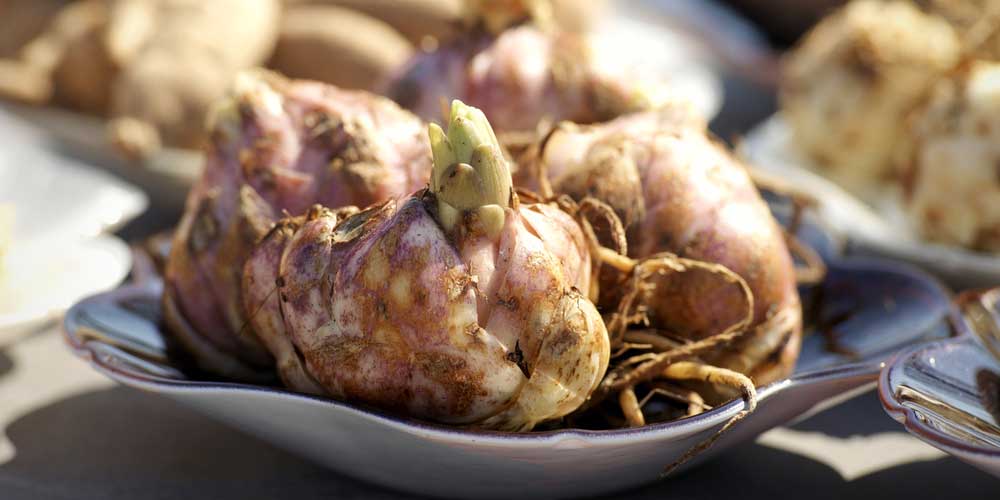
The scaly bulbs of lilies, composed of imbricate scales (photo Steven Bemelman – iBulb)
After flowering, the lily produces capsules, divided into three chambers, containing a large number of seeds.
The main varieties
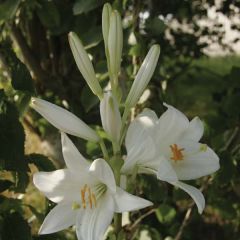
Lilium candidum - Madonna Lily
- Flowering time June, July
- Height at maturity 1,20 m
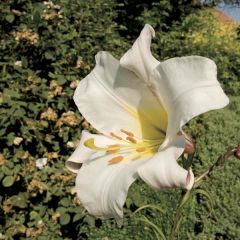
Lilium regale - Lily
- Flowering time July, August
- Height at maturity 1,30 m
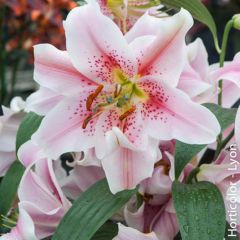
Lilium Mona Lisa
- Flowering time August, September
- Height at maturity 75 cm
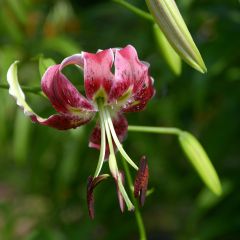
Lilium Black Beauty
- Flowering time September, October
- Height at maturity 1,50 m
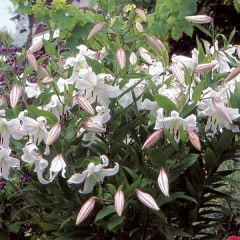
Lilium Casa Blanca - Lily
- Flowering time August, September
- Height at maturity 1 m
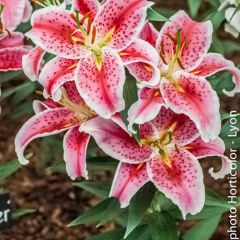
Lilium Stargazer - Lily
- Flowering time August, September
- Height at maturity 75 cm
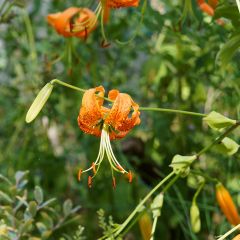
Lilium henryi
- Flowering time September, October
- Height at maturity 2 m
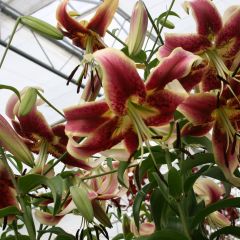
Lilium Scheherazade
- Flowering time August, September
- Height at maturity 1,50 m
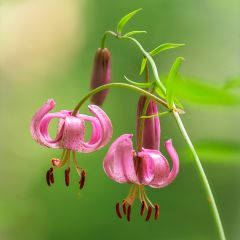
Lilium martagon - Lily
- Flowering time July to September
- Height at maturity 1,50 m
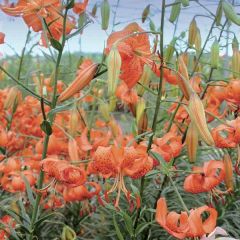
Lilium lancifolium Splendens
- Flowering time July to September
- Height at maturity 1,30 m
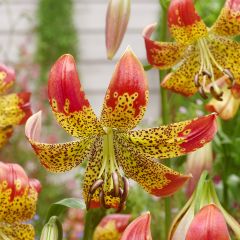
Lilium Fusion
- Flowering time July, August
- Height at maturity 90 cm
Discover other Lilies
View all →Available in 0 sizes
Available in 0 sizes
Available in 1 sizes
Available in 1 sizes
Available in 1 sizes
Available in 1 sizes
Available in 1 sizes
Available in 1 sizes
Available in 0 sizes
Available in 0 sizes
Planting Lilies
Where to plant?
Lilies love full sun! Ideally, they should be placed in a sunny location, but with the base in the shade. A slightly shaded, bright spot will also suit them. Preferably, place them in a sheltered area away from the wind.
Lilies prefer soils rich in organic matter. They thrive in loose, well-draining soils where water easily infiltrates. Stagnant moisture could promote fungal diseases. Madonna Lily truly needs a well-draining substrate and tolerates drought better than other species, which prefer soil that remains relatively cool in summer.
Most species prefer rather acidic soils and do not like calcareous substrates. However, Madonna Lily, Henryi Lily, and Martagon Lily tolerate lime well.
While giant lilies are perfect for borders, where they will provide height and structure, the more compact varieties can be planted in pots or containers, for example, to enhance a terrace.
When to plant?
It is best to plant lilies in autumn, around September – October, but planting can easily be done until March, or even until May-June, for most varieties. Avoid periods of severe frost. Planting in autumn allows the bulb to start settling in and developing its root system for better flowering the following year. However, Asian lilies are best planted in spring.
Madonna Lily, on the other hand, should be planted in late summer or early autumn, ideally in August – September.
How to plant?
For a more visually appealing effect, we recommend planting them in groups, gathering at least five bulbs. Maintain a distance of 15 to 20 cm between the bulbs.
Bulbs do not keep well out of the soil: plant them as soon as you receive them, without delay. They are often stored in moist turf to prevent drying out, which can lead to mould at the end of the season. If the bulb is slightly damaged on the surface, it is not a problem; you can plant it. However, if it is soft or has started to rot, it is better to discard it.
- Dig a planting hole, possibly using a bulb planter. You can add some potting soil at the bottom. Do not hesitate to add a layer of coarse sand or gravel, especially if your soil is heavy and retains water.
- Place the bulb. Plant at a depth of about 15 cm (under two to three times the size of the bulb), except for Madonna Lily, which should be planted very close to the surface, under 2 or 3 cm of soil.
- Cover with a mixture of soil and well-decomposed compost, as lilies sometimes produce roots on the part of the stem that is buried.
- Water generously.
- Place a small stake to remember the location.
Also, check out our video tips on planting Lilies and our tutorial How to replant lilies in pots in the garden?
You can also plant in pots or containers. Choose a sufficiently large container, place a drainage layer at the bottom (gravel, clay balls, broken pots…). Install a light and rich substrate, for example, a mixture of coarse sand, compost, and garden soil. Plant the bulb, cover it, and then place the pot in a sunny location.
→ For more information, check our advice sheet on the cultivation of Lilies in pots
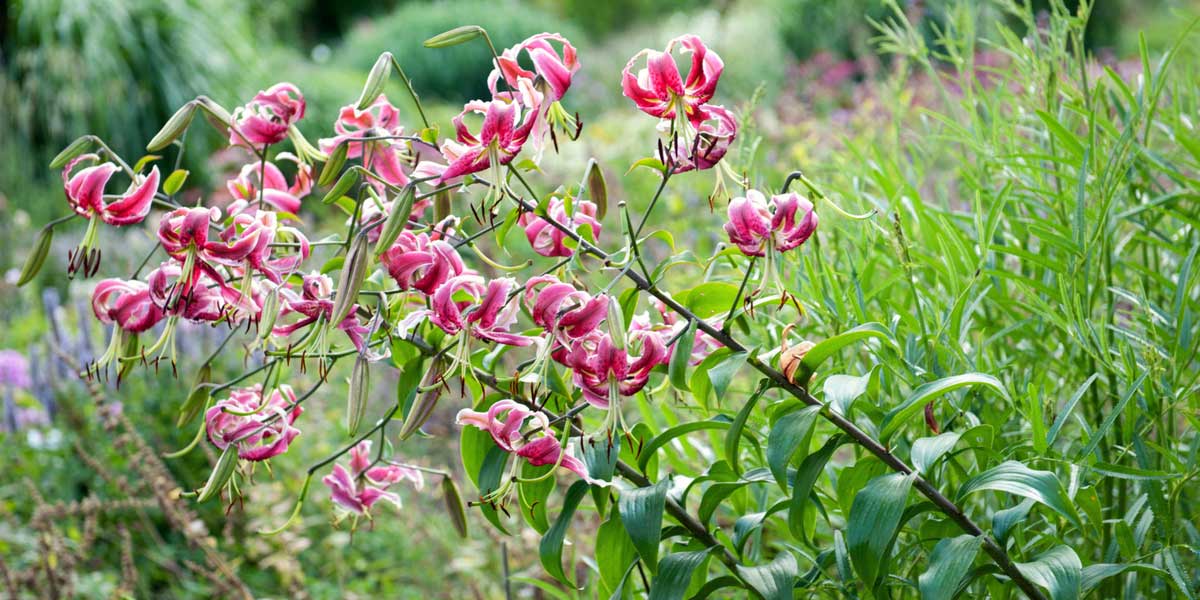 Lilium ‘Black Beauty’ (photo Friedrich Strauss – Biosphoto)[/caption>
Lilium ‘Black Beauty’ (photo Friedrich Strauss – Biosphoto)[/caption>
The cultivation of Madonna Lily
Madonna Lily (Lilium candidum) is a unique plant that stands out due to slightly different cultivation conditions. It appreciates slightly calcareous substrates, tolerates drought well… Thus, it thrives very well in a Mediterranean climate! Its planting occurs at the very beginning of autumn, with the bulb placed close to the soil surface, unlike other varieties. It also experiences a summer dormancy period. Finally, it is often attacked by lily beetles, so vigilance is necessary. It also has the particularity of retaining leaves in autumn and winter, unlike most lilies, which are deciduous.
Read also
Lily beetle: dealing with attacksMaintenance
Water regularly to keep the soil moist during growth and flowering, especially in spring and summer. We recommend applying mulch to help keep the soil cool for longer! However, avoid excess moisture that could cause the bulbs to rot. For this reason, stop watering in autumn – winter, once the foliage has dried and the plant is dormant. Madonna Lily tolerates drought better than other varieties. The Lily will appreciate a liquid fertiliser, preferably high in potash, every two weeks during the growth and flowering period.
You won’t need to lift the bulbs in autumn: Lilies can remain in the ground over winter, as they are hardy and perennial.
As some lilies have roots on the stem, above the bulb, which allow them to anchor in the soil, they do not necessarily need staking to support their stems… However, staking may be considered for the taller varieties, which can reach two to three metres high!
Remove the flowers when they have faded. As soon as all the flowers on a single stem have wilted, you can cut the top third of the stem, no more, to leave enough leaves for the bulb to replenish its reserves.
Feel free to harvest the flowers to make bouquets! Cut the stem preferably at an angle, change the water in the vase regularly, and occasionally re-cut the base of the stem to ensure the flowers last longer!
In autumn, once the foliage has completely dried, you can cut back the clump to ground level.
Diseases and pests of lilies
The main enemy of the lily is the lily beetle! It is a bright red beetle with a black head and legs, measuring just under a centimetre long. It chews on the leaves and flowers, potentially causing significant damage. In spring, we recommend checking your plants every week in the morning. Monitor the foliage for black larvae, orange eggs, or adults (the lily beetle often hides under the leaves), collect them, and remove them manually. There is no other effective treatment. It is important to intervene early to limit the infestation. The Madonna Lily, Lilium candidum, is the most affected by the lily beetle.
Consult our video tips to recognise and eliminate it:
It is also common for slugs and snails to nibble on the lily foliage. Again, the Madonna Lily is particularly vulnerable. To combat this, you can create a slug trap or use a slug repellent like Ferramol. The lily can also be attacked by aphids. They pierce the foliage to suck the sap, causing deformation and weakening the plant. We recommend using black soap.
Regarding diseases, the lily is sometimes affected by Botrytis, also known as grey mould. A humid spring and poor air circulation promote its appearance. Avoid excess moisture and consider pruning plants near the lilies to allow air to circulate.
Lily bulbs are sensitive to excess moisture, which can sometimes lead to the appearance of fungi and diseases. This is why it is important to plant in well-draining soil and to reduce watering in autumn and winter when the plant is dormant.
→ Read also: How to protect your lilies from pests and diseases?
Multiplication
The best technique for multiplying lilies is propagation by cuttings of scales. Whether by sowing, propagation by cuttings of scales, or harvesting bulblets, lilies will take several years before flowering.
Sowing
Sowing should be done as soon as the seeds are ripe, without delay, as they will lose their seed viability afterwards. This means you have previously left faded flowers on your plants to allow them to produce seeds.
- Prepare a pot with special sowing compost.
- Sow the seeds.
- Cover them with a thin layer (about 5 mm) of sifted compost.
- Water gently.
- Place the pot under a cold frame.
Keep the substrate moist but not overly wet. Keep your young plants in pots for a year before planting them in the garden.
Propagation by Cuttings of Scales
Intervene in autumn, after flowering, once the foliage has dried.
- Prepare a tray or box with a draining substrate (a mix of compost and sand). Water it so that it is well moist.
- Dig up a bulb. It should be healthy, well-formed, and fairly large.
- Remove any dead or damaged parts, as well as those that are soft.
- Choose the largest scales located on the outside and gently detach them at the base. They should remain entire.
- Plant the base of the scales in the substrate. Bury them halfway.
- The ideal is to place a plastic bag over the tray to maintain a humid atmosphere.
- Place the tray in the shade, at a temperature of about 20 °C.
- Water regularly to keep the substrate fresh.
The scales will produce bulblets that will develop and give new plants. You can transplant the bulblets into individual pots as soon as they start to grow. Plant them in the ground the following autumn.
You will have to wait at least three years to see them flower!
→ Also discover how to multiply bulbs by scaling in our tutorial!
Harvesting Bulblets
Some lilies have the particularity of producing bulblets on their stems, at the axil of the leaves. This is the case, for example, with Lilium bulbiferum or Lilium lancifolium. You can detach them from the stem, place them in pots with a draining substrate. Cover them with two to three centimetres of compost, then water.
Associating lilies in the garden
With their very refined flowering, lilies easily integrate into a romantic garden. Moreover, many varieties offer pure white or soft pink flowers! They are ideal for bringing a lot of delicacy and elegance to the borders. You can easily plant them alongside roses, peonies, foxgloves, astrantias, and fraxinellas. Lilies will also be perfect near a pergola, for example, if you plant them in pots, to accompany the flowering of clematis!
Since their flowers are impressive and colourful, lilies fit well into mixed borders and summer beds, alongside other bright blooms. They will add both height, helping to structure the bed, and colour! Pair them with perennials such as agapanthus, coreopsis, gladioli, daylilies, and monardas.
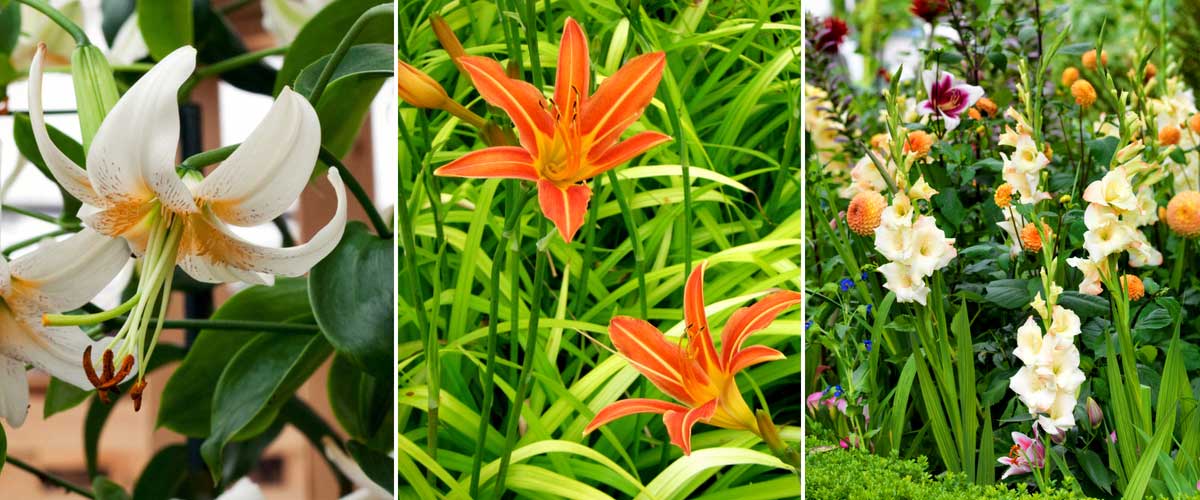
For a colourful bed: Lily ‘Lady Alice’ / Hemerocallis ‘Margaret Perry’ / Dahlias, Lilies, and Gladioli (photo Steven Bemelman – iBulb)
As lilies have a rather rigid appearance, with their very straight stems, it is advantageous to pair them with plants that have a more flexible habit and light flowers. Of course, we think of grasses, but also of Gaura lindheimeri, flax (Linum perenne), persicarias, or meadowsweet. Also, take advantage of the long spikes of Liatris spicata!
The botanical lilies (such as Lilium tigrinum, Lilium martagon, or Lilium henryi) can easily fit into naturalistic gardens. They have a more delicate and simple appearance than large-flowered hybrids. These are plants that can be found in nature with the same appearance, unlike horticultural varieties. Plant them with grasses, hardy orchids, gentians (notably Gentiana lutea), acanthus, and campanulas. Botanical lilies will also pair wonderfully with the pink flowers of Byzantine gladioli. Their shades can easily complement each other!
→ Discover more pairing ideas with Lilies in Sophie’s advice sheet!
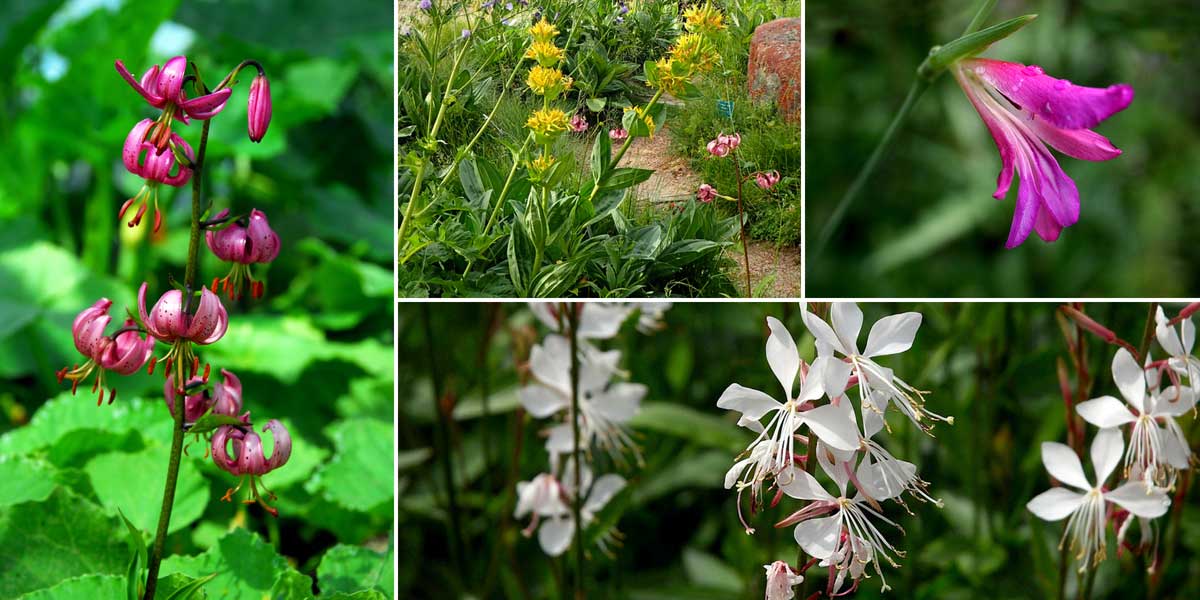
For a naturalistic garden: Lilium martagon (photo Wouter Koppen – iBulb) / Gentiana lutea and Lilium martagon / Gladiolus italicus (photo Jean-Pol Grandmont) / Gaura lindheimeri ‘Whirling Butterflies’
Did you know?
- The lily: a true symbol!
In Greek mythology, the lily is associated with the goddess Hera. The story goes that she nursed Heracles, son of Zeus, and that drops scattered in the sky created the Milky Way, while on earth they caused the lily to appear. This flower is also one of the emblems of French royalty. It is a heraldic symbol frequently found on coats of arms, tapestries, or fabrics related to the history of France. In Christian religion, the lily is a symbol of the Virgin Mary. This is what gives Lilium candidum its common name, Madonna Lily. The white flowers of the lily are a symbol of purity and innocence. They are often used to celebrate weddings.
- Medicinal virtues
The Madonna Lily, Lilium candidum, can be used in the form of a macerate to treat burns, cuts, or as an anti-wrinkle remedy. It has antiseptic, healing, and diuretic properties.
Useful resources
- Discover our wide range of lilies!
- For a naturalistic garden: our botanical lilies
- Check out our video tips – Planting Lilies
- Advice sheet – Dealing with Lily Beetle Attacks
- Our video tips – Identifying and Eliminating the Lily Parasite
- Advice sheet – Planting and Growing Lilies
- Advice sheet: Lilies, the Most Fragrant
- Advice sheet: Bulb Size: Understanding to Choose Better
- Our advice sheet: 7 Toxic Bulbs
- Our advice sheet: The Best Lilies for a Naturalistic Garden
- Our advice sheet: How to Choose a Lily?
- Our advice sheets: Why Aren’t My Lilies Flowering? and How to Have Lilies in Bloom All Summer?
- Our selection of 7 White Flowering Lilies for an Elegant Garden; The Most Beautiful Yellow Flowering Lilies for a Dazzling Garden; 5 Pink Flowering Lilies for a Romantic Garden; 5 Red Flowering Lilies for a Striking Garden; 5 Bicoloured Lilies for an Original Garden
Frequently asked questions
-
The leaves of my lily are holey; they look nibbled! What should I do?
This is likely the lily beetle. A bright red beetle that feeds on the leaves and flowers of the lily, potentially leading to the plant's demise. Inspect the foliage for signs of its presence. If you do find it, we recommend removing it manually. It is also possible that your lilies have been attacked by slugs and snails, which enjoy the young shoots and tender leaves in spring. To protect your young plants, you can use slug pellets.
- Subscribe!
- Contents
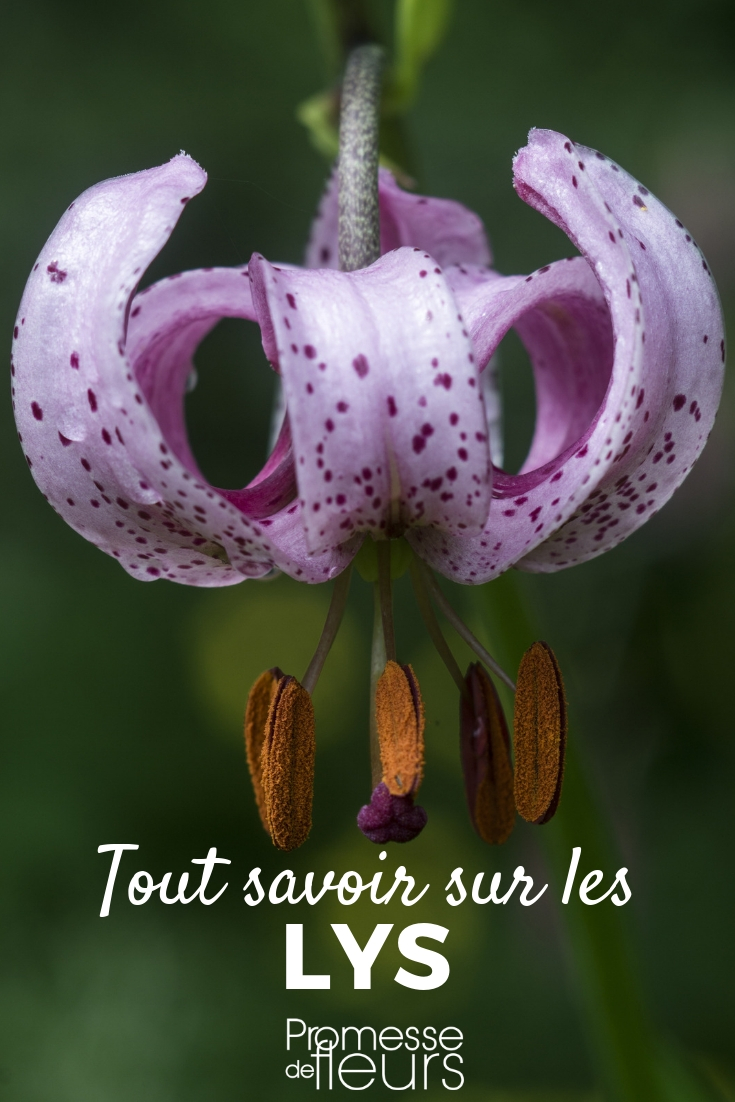































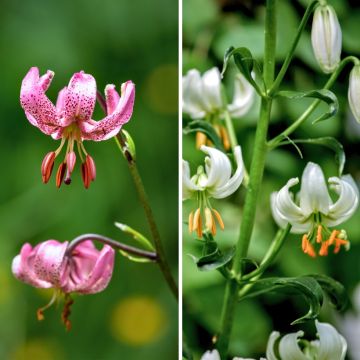


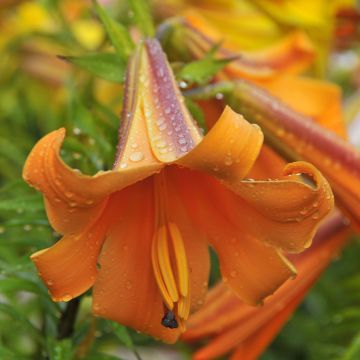
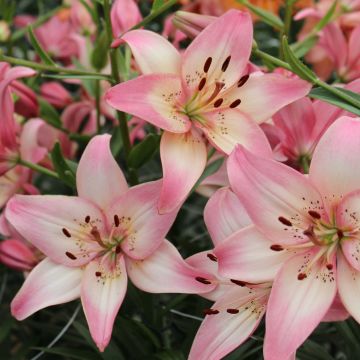
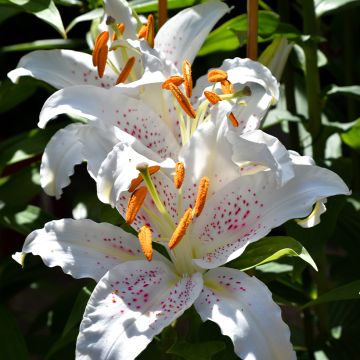
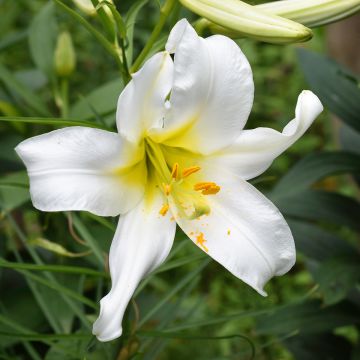

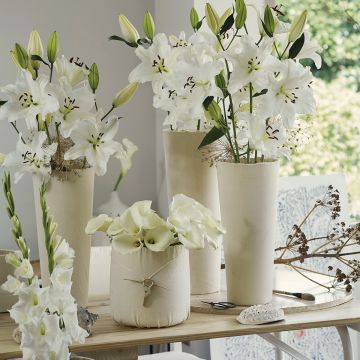
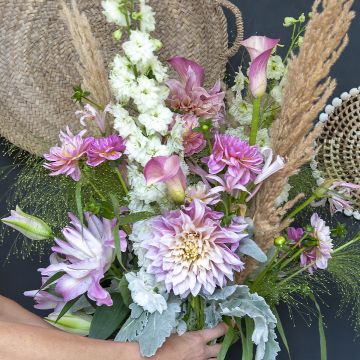
Comments